How Do We Balance Customization and Standardization in Our Software as We Scale?
Find out how to delight your clients while keeping your software scalable and stress-free.

When you’re scaling a software product, it feels a bit like juggling flaming swords while riding a unicycle. One wrong move, and you’ve got chaos. And one of the trickiest swords to handle? Balancing customization with standardization.
If you’ve been in the trenches of software development, you know the tension is real. Clients love customization. It makes them feel special, understood. But too much customization? It can turn your beautifully streamlined codebase into a sprawling mess—an unwieldy Frankenstein’s monster of technical debt.
As the founder of 1985, an outsourced software development company, I’ve had a front-row seat to this challenge across multiple industries. In this post, I want to walk you through how we’ve navigated this tightrope, sharing lessons learned, practical strategies, and a few scars we picked up along the way.

Why Is This Balance So Crucial?

The Cost of Too Much Customization
Let’s start with the obvious. Customization sounds great in theory. “Tailored solutions for every customer,” the marketing team proclaims. But for developers? It can be a nightmare.
Let's say you have ten enterprise clients, each with specific needs. One wants a custom report generator. Another demands a bespoke integration with their CRM. Over time, your codebase becomes a patchwork quilt—no two implementations alike.
Here’s the problem: every tweak you make introduces complexity. Bug fixes take longer. Testing becomes more intricate. And when you finally update your platform, those bespoke features? They break.
According to a study by McKinsey, nearly 17% of large IT projects fail due to complexity introduced by over-customization. The more you cater to everyone, the less maintainable your software becomes.

The Risks of Over-Standardization
On the flip side, let’s talk about standardization. It’s the holy grail of scalability. Standard modules, reusable components, and streamlined deployment pipelines—what’s not to love?
But here’s the catch: customers don’t like to feel like another cog in the wheel. If your software doesn’t address their specific pain points, they’ll start looking elsewhere. A Gartner report showed that 89% of businesses compete primarily on customer experience. Over-standardizing risks delivering a “one-size-fits-none” solution.
In short, too much customization kills scalability. Too much standardization erodes customer satisfaction. Striking a balance? That’s where the magic happens.

Defining Your Core Offering
Know What’s Non-Negotiable
Start by defining your core. What’s the heart of your product? What’s the feature set that makes your solution unique?
For example, at 1985, we specialize in developing SaaS platforms for healthcare startups. Our core includes HIPAA-compliant data storage, robust reporting tools, and integrations with popular EHR systems. These are non-negotiables. Every client gets these features, no exceptions.
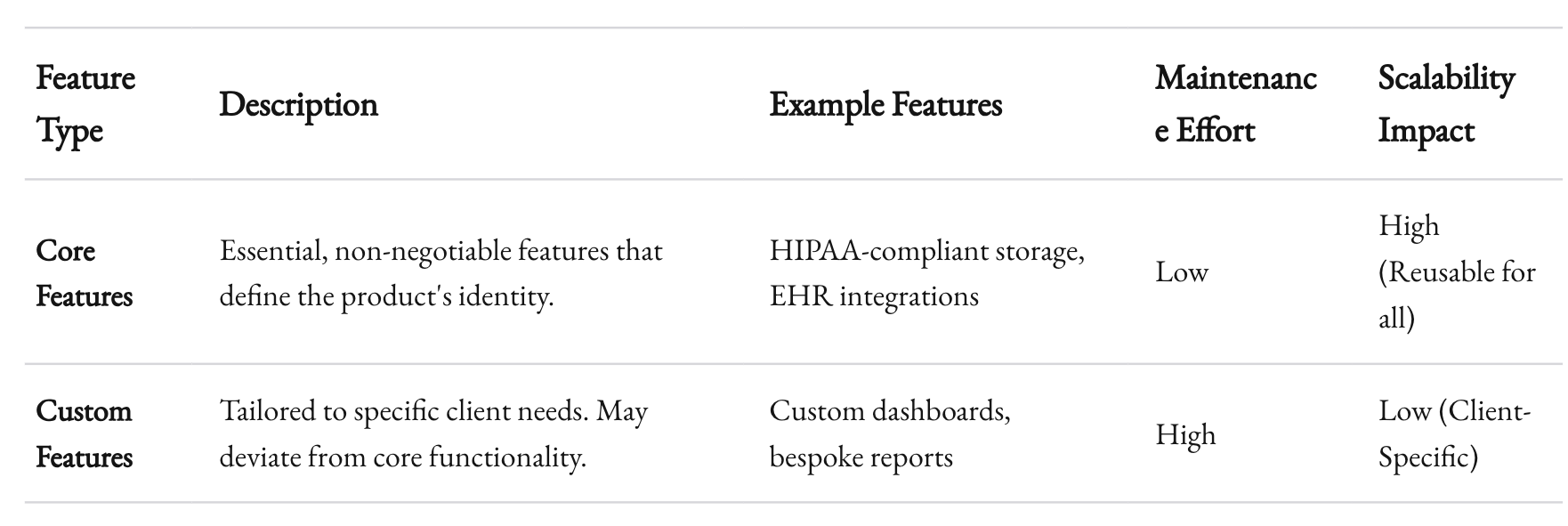
By identifying your core, you create a foundation that’s stable and scalable. Any customization you introduce will build on this base rather than undermine it.
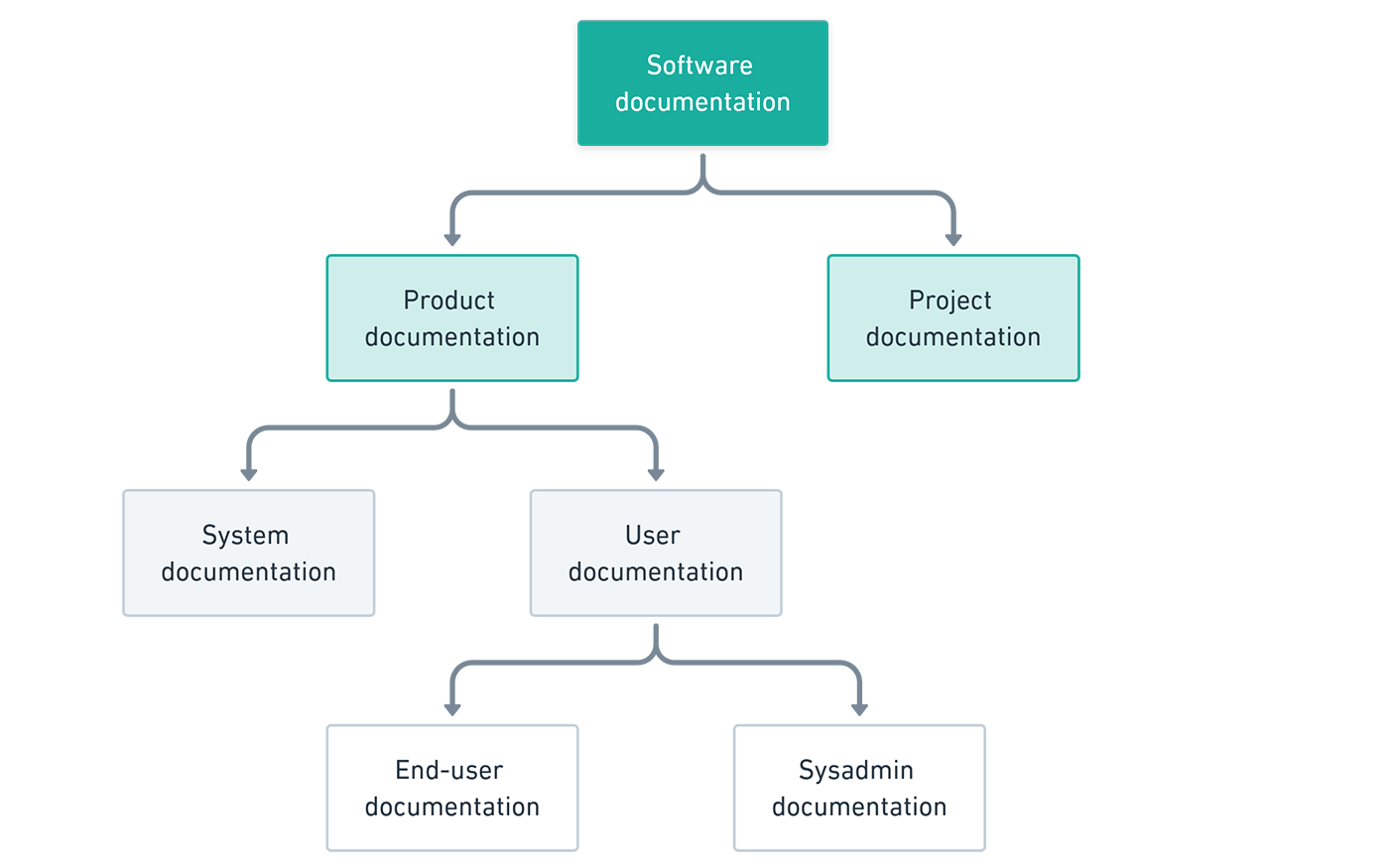
Document Everything
Documentation isn’t sexy, but it’s essential. When you’re scaling, it’s easy to lose sight of what’s core versus custom. Detailed documentation helps your team stay aligned.
Pro tip: maintain a “living document” that gets updated with every release. Include:
- Core functionality
- Common customizations
- Deprecated features (and why they’re no longer supported)
Customization: Setting Boundaries
Modular Architecture Is Your Friend
A modular approach to architecture is like having Lego bricks instead of glued-together toy cars. Each module is a self-contained unit. Need to add a custom feature? Build it as a new module rather than tweaking the core.

For example, one of our healthcare clients needed a patient-facing dashboard. Instead of hardcoding it into their existing system, we built it as a standalone module. This allowed them to offer it as an optional add-on for other customers.
Say “No” (Strategically)
Not every client request deserves a green light. Saying “no” is hard, especially when a lucrative contract is on the line. But a well-placed “no” can save your team months of headaches.
How do you decide? Create a framework:
- Alignment: Does the request align with your long-term product vision?
- Scalability: Can this feature be reused across multiple clients?
- Complexity: Will it introduce unnecessary technical debt?
If the answer to two or more of these questions is “no,” politely decline.
Standardization: Getting It Right
Build Configurable Options
One of the best ways to balance customization and standardization is through configuration. Instead of building one-off features, create flexible settings.

For example, rather than hardcoding different workflows for different clients, offer a workflow editor. Clients can tweak the process to their liking without needing custom code.
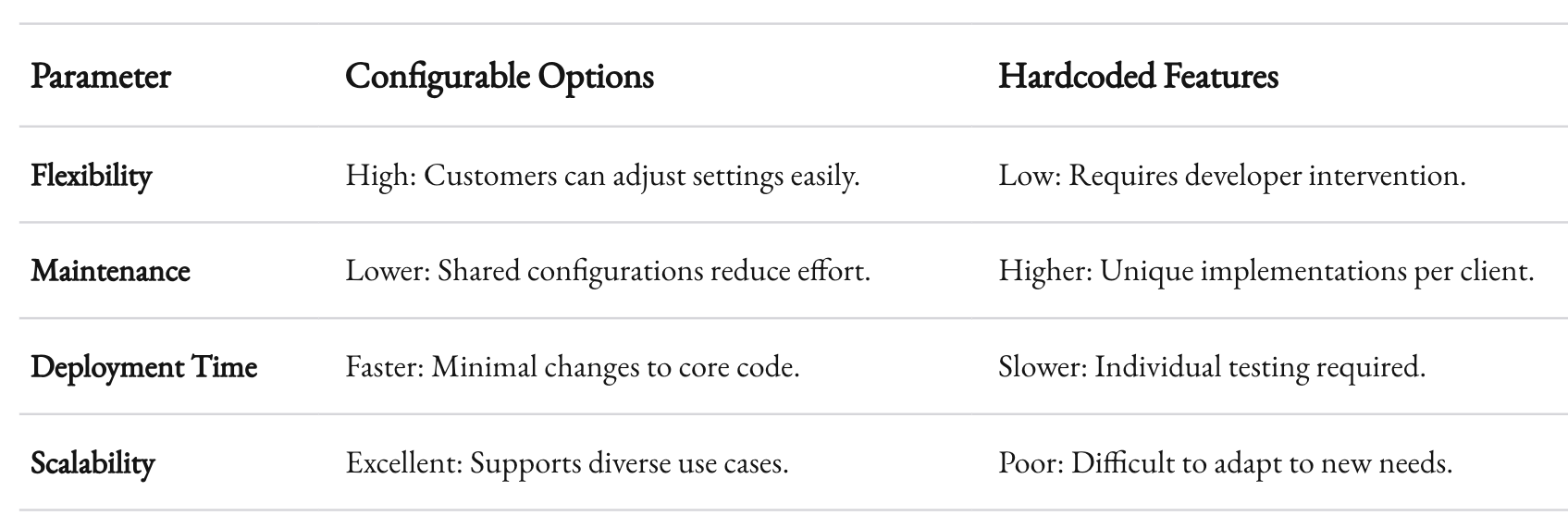
Automate Repetition
Scaling requires efficiency. Automation is your best friend here. Invest in tools that streamline repetitive tasks:
- CI/CD Pipelines: Automate testing and deployment.
- Infrastructure as Code: Standardize your environment setups.
- Code Generators: Build boilerplate code for common use cases.

Automation not only saves time but also ensures consistency across projects.
When Things Go Wrong
Warning Signs
Despite your best efforts, the balance can tip. Here are some red flags to watch for:
- Rising Bug Count: A spike in bugs after updates often signals excessive customization.
- Longer Release Cycles: If every new feature takes ages to ship, your processes might be too rigid.
- Customer Churn: Complaints about inflexibility could indicate over-standardization.
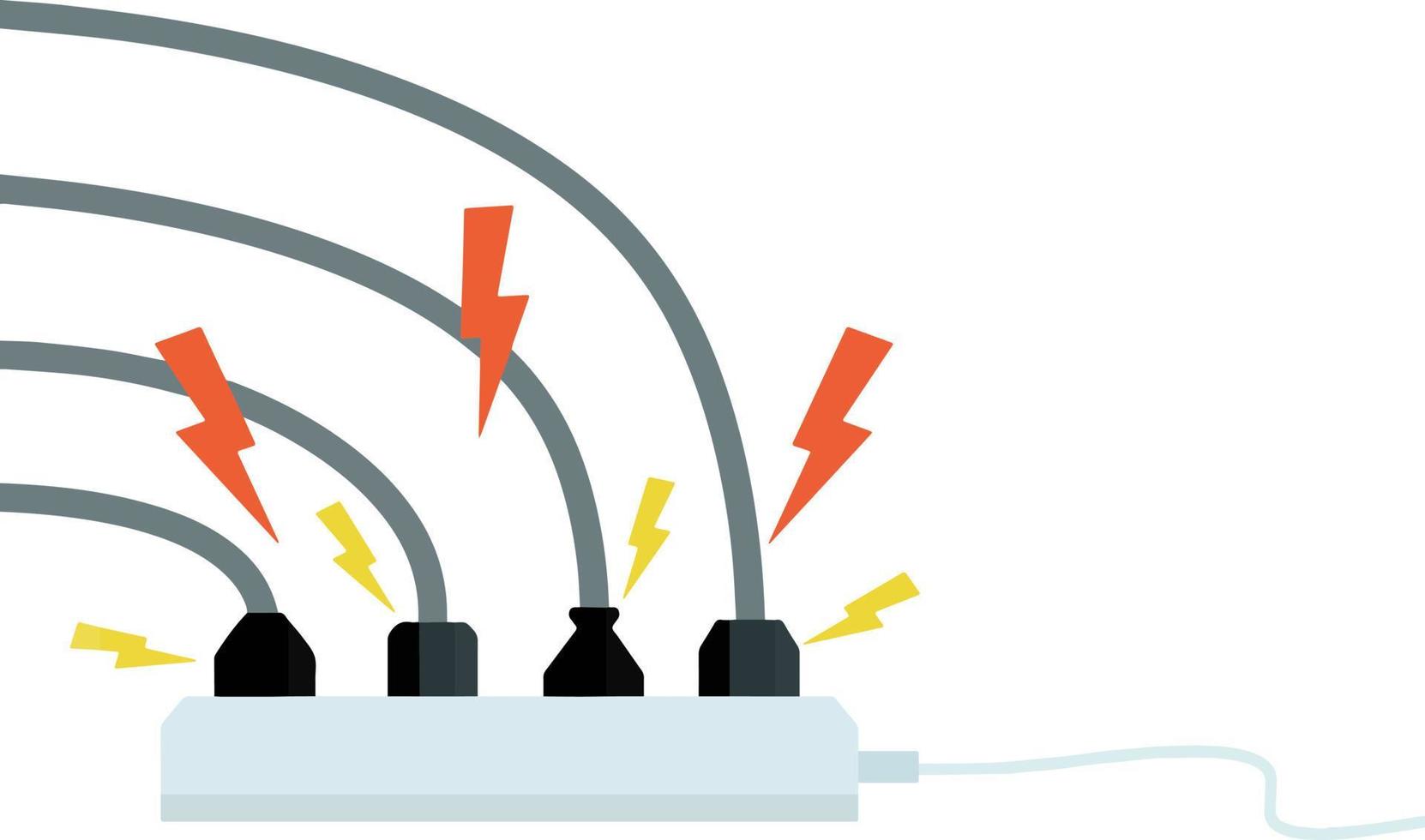
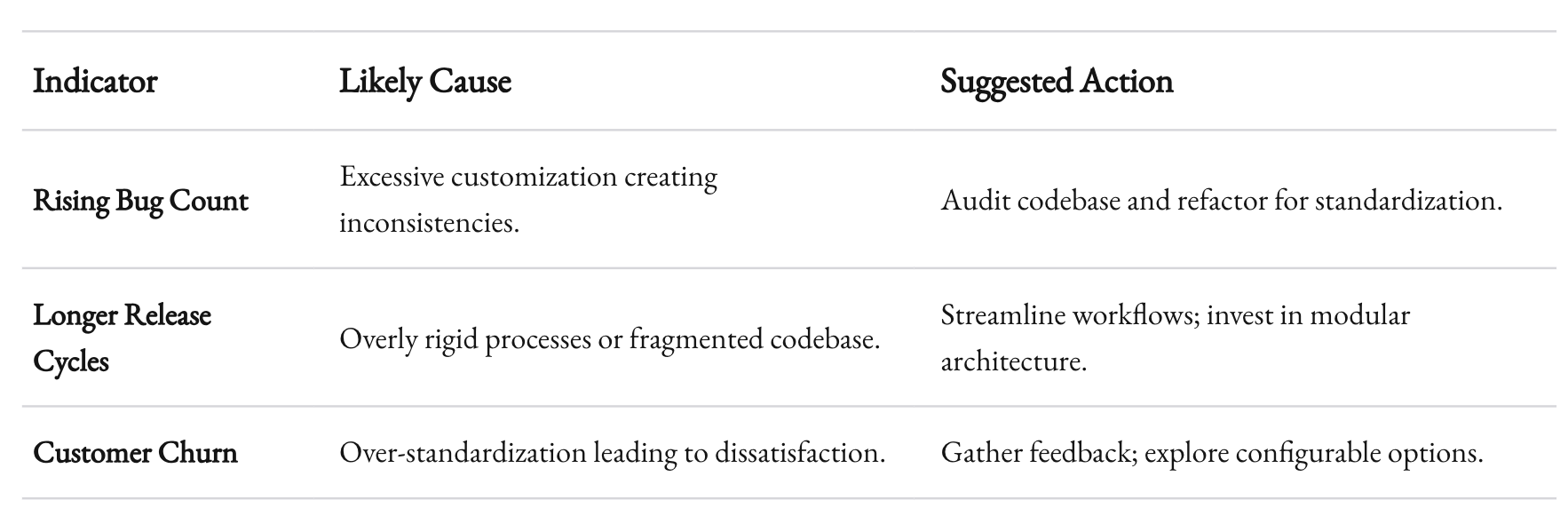
Course Correction
When things go off track, don’t panic. Gather your team and reassess:
- Audit the Codebase: Identify areas with high complexity or redundancy.
- Talk to Customers: Understand their pain points. Are they asking for more customization or simpler solutions?
- Revisit Your Roadmap: Adjust priorities based on what you’ve learned.
A Practical Example
Let me share a quick case study from 1985. A few years ago, we worked with a logistics startup scaling their operations. They wanted custom dashboards for every client. Initially, we obliged. But six months in, the technical debt was overwhelming.

Here’s what we did:
- Identified Commonalities: We noticed 80% of the dashboards shared similar metrics.
- Built a Template: We created a customizable dashboard template, allowing clients to choose their metrics.
- Rolled Out Incrementally: Instead of a big-bang launch, we introduced the template to a few clients and iterated based on feedback.
The result? Faster deployments, fewer bugs, and happier clients.

Final Thoughts
Balancing customization and standardization is an art, not a science. It requires constant vigilance, open communication, and a willingness to adapt. The goal isn’t to find a perfect 50/50 split. It’s about making deliberate choices that align with your product vision and your customers’ needs.
If you’re scaling your software and feeling the weight of this balancing act, know that you’re not alone. We’ve all struggled with this tension. The key is to approach it with clarity, strategy, and a touch of humility.
As we like to say at 1985: build smart, scale smarter.



